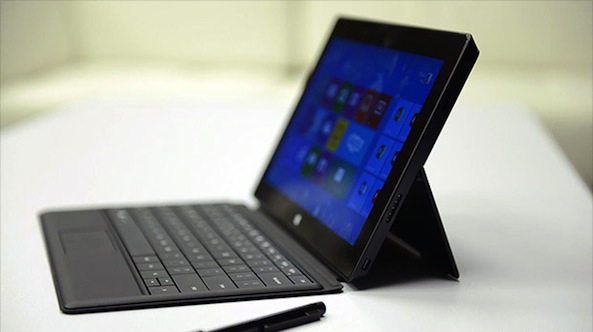
So roughly two out of each three respondents in our poll say the new 128GB iPad 4 is going to be a tough sell when it arrives on February 5 .
Some folks say there’s no point in shelling out $929 for a top-of-the-line 128GB cellular iPad when a $70 more buys you an 11-inch MacBook Air.
And even though the entry-level Air has only half as much storage as the new 128GB iPad, it’s a real computer, critics argue.
Comparing apples to oranges doesn’t make sense, but what does is how Microsoft admitted â€" and on the day Apple announced the new 128GB iPad 4 offering, of all days â€" that the 128GB Surface Pro has only 83 gigabytes of free storage out of the box.
It ain’t just a serious rounding error: a whopping 45GB is consumed by the Surface OS and bundled apps, Microsoft confirms…
Microsoft in a statement this morning (via Engadget [1] ) clarified that people can always free up additional storage space “by creating a backup bootable USB and deleting the recovery partitionâ€.
But not all customers are geeks (most aren’t) and no sane person should ever be required to delete the recovery partition and create a backup bootable USB just because Microsoft fails to fulfill the advertised promise of a 128GB device.
Here’s Microsoft’s statement in its entirety:
The 128 GB version of Surface Pro has 83 GB of free storage out of the box. The 64GB version of Surface Pro has 23GB of free storage out of the box. Of course, Surface Pro has a USB 3.0 port for connectivity with almost limitless storage options, including external hard drives and USB flash drives.
Surface also comes pre-loaded with SkyDrive, allowing you to store up to 7GB of content in the cloud for free. The device also includes a microSDXC card slot that lets you store up to 64GB of additional content to your device.
Customers can also free up additional storage space by creating a backup bootable USB and deleting the recovery partition.
Storage rounding errors aren’t new.
In reality, one megabyte has 1,024 kilobytes, one gigabyte has 1,024 megabytes, one terabyte has 1,024 gigabytes and so forth. But vendors prefer to round these numbers so in their parlance, one gigabyte has a thousand megabytes, for example.
This isn’t just for the sake of simplicity.
It’s a marketing scam that artificially increases advertised capacity of storage products. As unfortunate as it is, this has become a widespread industry practice and pretty much every single vendor out there is guilty of it, Apple included.
And yes, they tell readily inform you about it â€" you just don’t read the fine print, do you?
Exhibit A: a disclaimer found at the bottom of Apple’s iPad mini specs page [2] reads that “1GB = 1 billion bytes; actual formatted capacity lessâ€.
Check out this storage rounding errors table.

Handy table detailing storage rounding errors via OpenLife.cc [3] .
In the case of the 1GB region, your rounding error is about 74 MB.
But multiply this with 128GB of storage for the Surface Pro/iPad, and suddenly the difference in getting your numbers right makes nearly ten gigabytes worth of a rounding error.
Even that pales in comparison with the difference between the advertised and actual capacity of the 128GB Surface Pro â€" 45 gigabytes.
Taking into account the rounding error of ten gigabytes on 128GB, plus the inevitable file system overhead, should leave us with just a little north of 30 gigabytes for the Surface OS and bundled apps.
Now contrast this to iOS which takes up about one gigabyte of device storage.
We knew from before that Surface OS is a resource hog .

In addition, Microsoft previously clarified that the 32/64GB Surface RT has approximately 16 and 46GB of free storage, respectively.
Be that as it may, Microsoft’s policy here just doesn’t feel right.
How exactly does Microsoft justify complaints from consumers who’d discover after buying a 128GB Surface Pro they actually have 83GB, or 36 percent less storage space at their disposal?
And what if you bought a 64GB Surface Pro?
Your free storage out of the box would come only at a rather paltry 23GB as junkware and the OS eat up nearly two-thirds of storage space on the 64 gig Surface Pro.
Let me put this another way: Microsoft is about to ship the 64GB Surface Pro with as little as 36 percent of advertised storage available to users.
Before Microsofties scold me in the comments, just imagine the commotion if Apple tried to pull such a scam.
Some folks think [4] that a 128GB Surface Pro is a better buy than a 128GB iPad 4.
By TechnoBuffalo [5] :
At its starting price point of $800, the tablet is just $200 cheaper than a MacBook Air. It’s also $200 cheaper than Microsoft’s entry-level Surface with Windows 8 Pro tablet. Those are full featured computers that can run full desktop applications.
I wholeheartedly disagree (that one should go with a Surface Pro and not with an iPad).
The way I go about this dilemma: I can go with a tablet that has 36 percent less usable space than advertised and costs like a MacBook Air. Or, I can pay $200 less to get an iPad, the best tablet in the world, and still have 115+GB of usable space.
What on Earth was Microsoft thinking?
And whose tablet is a tougher sell now?
Note: a 128GB Wi-Fi iPad 4 is a $799 value and a 128GB Wi-Fi Surface Pro is $999. The entry-level 11-inch MacBook Air with 64GB of flash storage is priced at $999.
Links
- ^ Engadget (www.engadget.com)
- ^ iPad mini specs page (www.apple.com)
- ^ OpenLife.cc (openlife.cc)
- ^ Some folks think (www.technobuffalo.com)
- ^ TechnoBuffalo (www.technobuffalo.com)

No comments:
Post a Comment